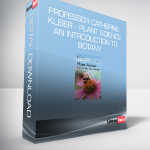Professor Catherine Kleier – Plant Science – An Introduction to Botany
Original price was: $234.95.$52.00Current price is: $52.00.
Recent scientific research from botany has offered astonishing revelations about the diurnal sleeping and waking cycles of trees. And DNA analysis proves fungi are actually more closely related to humans than to plants. These and many other discoveries illuminate the ways taxonomic identification of plants has changed with the advent of DNA sequencing and other cutting-edge scientific breakthroughs, allowing for a greater understanding of the world around us, such as:
- Description
- Reviews (0)
Description
Professor Catherine Kleier – Plant Science – An Introduction to Botany
In the 24 lectures of Plant Science: An Introduction to Botany, Dr. Catherine Kleier invites us into the uniquely satisfying world of plants, and the joy of celebrating and learning from the secrets of living nature. As Dr. Kleier shares her tremendous depth of knowledge with contagious excitement for her subject—supported by fascinating graphics and in-studio demonstrations—she emphasizes the “stories” of plants themselves: Without neglecting genetics or cell microbiology, or larger ecosystems and habitats, her primary emphasis is always on how plants we see all around us live and adapt. Dr. Kleier shares with you the pleasures of being able to identify and understand the workings of that tree just outside your window – and of any other plant you may encounter.
With almost 400,000 known species and thousands more identified every year, the variety of plant life is almost overwhelming—from the microscopic to the largest organism on Earth. In Plant Science: An Introduction to Botany, you will explore the astonishing adaptations that allow plants to live in an enormous variety of ecosystems, from deserts and the ocean floor to thousands of feet above sea level and on every continent. You will understand why there are no fewer than three kinds of photosynthesis, how the process separates plants from animals, and why many plants rely on symbiosis with bacteria and fungi in conjunction with photosynthetic processes.
See Plants in a New Way. And Another New Way.
Recent scientific research from botany has offered astonishing revelations about the diurnal sleeping and waking cycles of trees. And DNA analysis proves fungi are actually more closely related to humans than to plants. These and many other discoveries illuminate the ways taxonomic identification of plants has changed with the advent of DNA sequencing and other cutting-edge scientific breakthroughs, allowing for a greater understanding of the world around us, such as:
How scientists, never able to grow lichen in the lab, finally determined that lichen is neither plant nor animal, but a “sandwich” of three distinct organisms
How plants, no less than beavers building a dam, are “ecosystem engineers” and capable of protecting their territories
Why you rarely see blue plants
Why 600 species of plants eat animals for nutrients, while others are outfitted with poison-injecting hairs
How some plants can grow to enormous size, like grass that can reach to 130 feet tall and leaves measuring more than 80 feet long, or trees that bear 92-pound fruit
The science behind genetically modified organisms and the real issues presented by GMO technology
Botany: Stranger than Fiction
Plant Science: An Introduction to Botany begins with lectures that address shared features of plants, how they resemble and yet differ from humans, and why there are few truly universal rules that govern all plants in exactly the same way. Instead, later lectures reveal how natural selection has allowed plants to adapt to the widest possible range of environments all around the globe. These adaptations have led to plant adaptations so surprising that they almost seem to have sprung directly from science fiction, such as:
stone plants with transparent “windows” to let in just the right amount of sunlight
leaves that can photosynthesize underground and others that produce antifreeze
trees that produce a sought-after waterproofing substance (suberin) that chemists have never been able to duplicate in a lab or even fully describe
a plant in which only 5 percent of cells are alive at any given time, which nevertheless creates its own ecosystem and continually modifies its habitat
the oldest living individual tree, which began its life near the end of the Neolithic period, more than 5,000 years ago
a seed in Siberia that remained viable for 31,800 years before germination
a tropical tree (Hura crepitans) that shoots its seeds at speeds up to 150 miles per hour, which also happens to be the maximum speed ever measured in the animal kingdom
mushroom fairy rings and how the associated hyphae work to enrich the soil for further fungal growth
an 11,000-year-old creosote clone in the Mohave Desert
the heaviest, oldest, and largest organism on planet Earth—a 107-acre, 80,000-year-old, 6,600-ton aspen (Populus tremuloides) genet—36 times heavier than the blue whale, the largest modern animal.
Get Professor Catherine Kleier – Plant Science – An Introduction to Botany download
While relatively few reproductive methods exist in the animal kingdom, plants have evolved a startling variety of methods for both asexual and sexual reproduction. Many of the most ancient reproductive methods, such as spores, are still successful today and support tens of thousands of species. While other reproductive mechanisms evolved in later periods, each provides unique benefits and challenges. For example, a flowering plant must “figure out” how to move male gametes to the female ovules, so the fertilized ovules can grow into seeds inside the fruit. Given that individual plants are not mobile, how do they accomplish this feat? Explore different aspects of plant reproduction, including:
the benefits of sexual vs. asexual reproduction
the roles of wind and water in plant reproduction
plants that are completely dependent on animals for their reproduction—in some cases only one species of animal
the many “tricks” plants use to entice animals into their reproductive process, including those whose flowers look and smell like female insects to lure in males for “mating”
“deceit pollination” and why it works
how plants recognize and address self-pollination
the role hormones play in the reproduction of the squirting cucumber (Ecballium elaterium)
A Passionate Adventure with Plants
Dr. Kleier also introduces fascinating questions botanists are still working to answer. We know plants can sense and respond to their environments, but can they remember their experiences? We know plants communicate to others in their vicinity via chemical signals, but is it also possible some plants have evolved an ability to detect sound waves? We know certain plants respond to touch, but can they be conditioned to “learn” when it is unnecessary to respond? And perhaps the most basic of questions: what exactly is a species? Now that scientists have access to genetic techniques such as DNA fingerprinting, it is relatively easy to find different alleles for different genes. But how many different alleles does it take to identify a new species? It’s an ongoing and exciting debate in the ever-changing world of botany.
Botanists are constantly examining and evaluating the natural world, and Dr. Kleier is passionate about working in the field and observing plants as they exist in their many habitats and varieties, a passion that comes through in every lecture as she teaches you how to do the same. As presented in this course, botany is a science rooted in experience with plants, a vibrant set of encounters that breathe life even into the plant diagrams and long scientific names of traditional biology.
Learn to see the world around you afresh as you read the stories of plant life for yourself with a professor who transforms science into an adventure.





Reviews
There are no reviews yet.